Platforms, you said platforms
The platform concept is very trendy these days. This blog post is about explaining it and sharing some feedbacks on two real use cases we have at Michelin
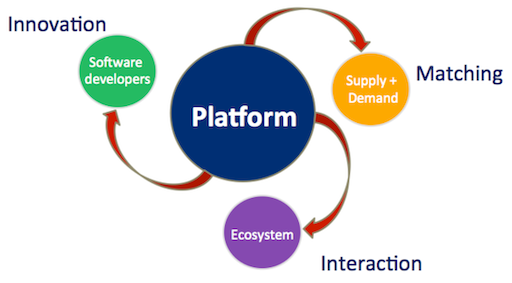
You probably noticed it already, but everyone wants to build a platform these days. In the last three weeks, I met people talking about a data platform, service platform, collaboration platform, customer data platform, consumption platform ... Some of them will probably end up being platforms but hard to tell at the first glance. Beyond the buzz, the platformisation is a real trend in many areas and markets. It started in the IT industry 3 decades ago but expanded way beyond as we can now find platforms in almost all industries. The purpose of this article is to try to clarify the concept of platform, the consequences of adapting a platform model and give some feedback on two experiences we had at Michelin.
Some definitions
Words are hard! When used in the context of changing business model to move away from sellings goods or services and be in the business of enabling interactions, we're talking about business platform. That's a big paradigm shift as such companies have to move away from the thinking of "my“ product or "my“ service. In a platform world you become the orchestrator of multiple parties. Your job is no longer to develop new products, your job is to facilitate the transaction between participants.
"A Business Technology Platforms is built to attract, make meet and connect people or companies to allow them to make transactions" Francis Nappez, CTO & co-founder of BlaBlaCar
Making transactions here can take many forms:
- intermediating providers and consumers to ease the selling of good and/or services
- developing a new app/service from existing service / data, exchanging content (media, information …).
- ...
We can find two main forms of BTP : intermediation and innovation platforms. The first is really about matching a demand with an offer getting a fee along the way. Uber and AirBnb are the most famous examples we can find. But we do have such platforms at Michelin in the hotel booking field with Tablet Hotels and when we help Americans truck fleets to find dealers to execute operations on trucks and minimize downtimes. The second is more about developing new products & services reusing features provided by the platform. Android and Amazon AWS are the reference here but Michelin is building data platforms in this spirit: reducing the time to market to deliver data products.
The below figures illustrates these two BTP types:
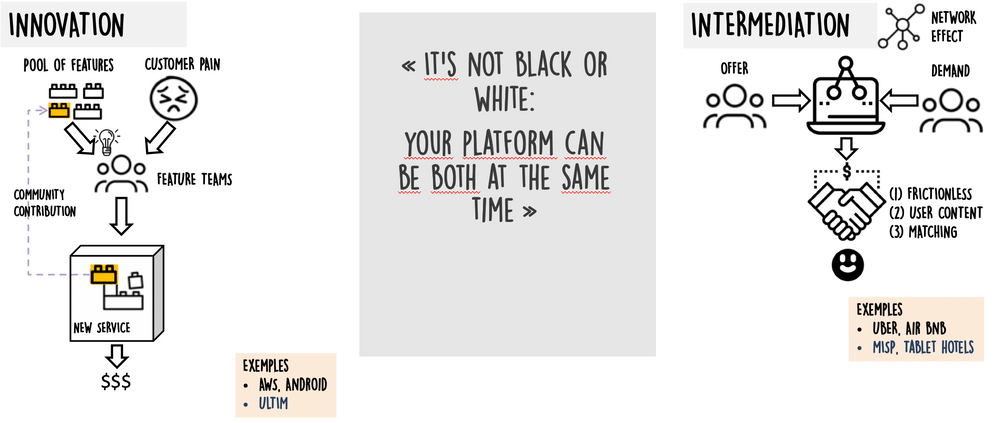
But platforms are also used within IT for many years if we consider the successful technology platforms of the past few decades: IBM 8086 process, Linux & Windows operating systems, Borland Delphi, the Java Virtual Machine, the .Net Framework, Pivotal Cloud Foundry, Microsoft Azure, and (recently) the container platform Kubernetes. They all succeeded in reducing the complexity of the underlying systems while exposing enough features to be useful to teams building on them. In that context, an IT platform is then an enabler reused by other teams to deliver faster what they have to.
I will use the definition of Evan Bottcher, Head of Engineering Thougtworks to illustrates what we call IT platforms at Michelin:
"A digital platform is a foundation of self-service APIs, tools, services, knowledge and support which are arranged as a compelling internal product. Autonomous delivery teams can make use of the platform to deliver product features at a higher pace, with reduced co-ordination."
Within the One System initiative at Michelin, we created a set of IT platforms around key technical capabilities (such as containers, databases, streaming ...).
Key elements of a platform
Regardless the type of platform (BTP or IT), the first key elements of a platform is not technical: you have to think about the interactions that can occur on your platform.

Keep in mind that behind any interaction, there is a value. The utility of a platform is then proportional to the number of interactions it can generate.
"In a platform world you become the orchestrator of multiple parties. Your job is no longer to develop new products, your job is to facilitate the transaction between the participants." Sangeet Paul Chaudhary, author of Platform Scale
In some cases, the value creation (ie the number of interactions) can increase in a nonlinear way due to what we call “the network effect”. The network effect is when the created value can increase geometrically if each additional user can connect to all other users or benefit from all other innovative products and services already accessible to members of the network. This network of members is what we call the ecosystem of your platform and that's the second key element.
If we look at the Uber example, it's interesting to observe the virtuous circle (ie the network effect) that is in place: once Uber is available somewhere (which means they solved the chicken & egg problem see below), the more driver you have, the bigger your geographic coverage is and that reduces the pickup time and driver downtime impacting the prices (lower) and at then end increasing the demand. Brilliant isn't it?
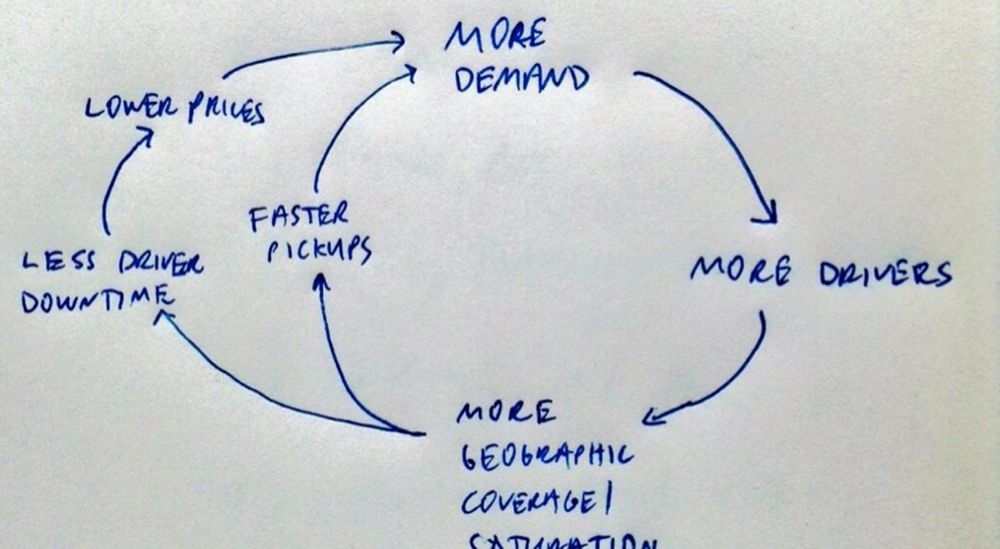
So in your context, what's your interaction? How can you generate more and more transactions? What is your strategy to try to generate such effect?
Let's pretend you have answers to those questions, don't you also have to solve the chicken and egg problem? it's a quite common problem in the platform world: does your platform have enough offer and demand to be sustainable. In the AirBnB case, it means enough appartments to offer and enough consumers to rent them. For an IT platform, do you have enough features to offer so developers are willing to use them. Defining a strategy to on-board your users is definitively something you have to do.
Feedback from the trenches
I'll pick two different examples at Michelin to share some feedback on the platform model. The first one will be on IT platforms within the Evergreen initiative. While the second will be a pure BTP platform (intermediation) coming from an acquisation Michelin made 2 years ago.
Evergreen IT platforms
Evergreen is an initiative at Michelin aiming to modernise our One Information System. It's an aggregation of many sub initiatives but the one we're interested in here is the creation of IT platforms. We identified couple of key IT capabilities that needed to be managed and exposed as IT platforms. One finds here integration tools, containers, infra as code, data bases ...
Why adopting a platform model in this space?
- we believe we could not achieve a continuous modernization of our information system without first modernizing our technical foundations. We saw the IT platform model as an enabler there.
- we were also especially interested in hidding the underlying complexity (we cold not afford having each team to master Kubernetes for instance) and providing autonomy to delivery squads through self-services and automation.
10 dedicated and long live teams were created to deliver these capabilities. Each of them adopted our lean & agiles principles: a product owner prioritizing the backlog and scrum ceremonies (sprint planning, backlog refinement, demos, retrospective ...). The below figure illustrates these IT platforms:

As you can imagine, these IT platforms can be interlinked because one is using the capabilities of the others for instance. These dependencies must be managed and here we got our inspiration from the @Safe framework: once every two months, all platform teams regroup in a system increment planning event (called Program Increment in Safe). This one day is used to synchronize all platform teams and get organized for the next 2 months. The different platforms' backlogs are consolidated into a single backlog representing our technologies roadmap. The chief PO (helped by platforms' POs) prioritizes this uniq backlog and a demo is done to get feedback on the previous MVP.
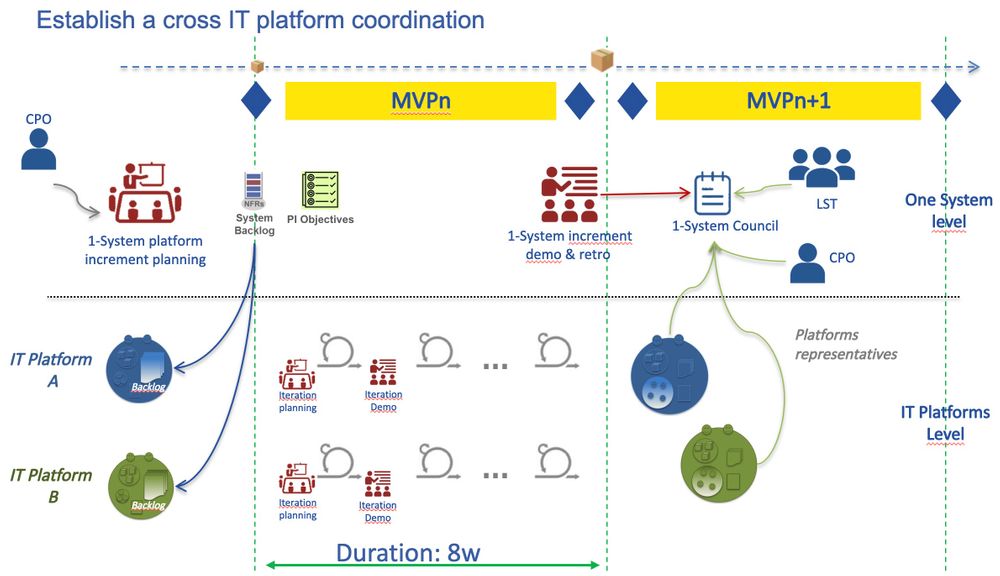
After a year and a half, this management system is well established and clearly helped to better manage priorities (ie investments) between these different platform teams. The main advantage is that through the Chief PO (representing stakeholders and "users"), we do manage priorities effectivly and ensuring a global coherence. This platform increment brings the coordination we were looking for without impacting the autonomy of platform teams. Indeed, the different platform teams still have their own backlog, ceremonies ... We now have a consolidated product roadmap shared and executed through MVPs.
There is another benefit we got from the creation of these teams. At the beginning of this initiative, our organisation was a bit siloed (still is) around 3 main areas: infrastructure, application and methods & quality. It's no surprise that we ended up with teams belonging to these siloes and as the communication was not always optimal, so does the communication between teams. We took the opportunity to implement a "inverse Conway maneuver" with the creation of teams made from people of these siloes. It worked tremendously well, with teams focused on the product objectives & not on the organization's agendas.
On the other side of the coin, the promise on the user experience is still not there. Delivering a platform means you're obsessed by your end-users and you try to make their life easier. You have to listen to them so you can improve your platform by releaving their pains. This is a day-to-day discipline and it takes time to get there. It means that as a platform team, you need
- to relie on fast prototyping techniques and involve delivery squads for fast feedback on what works and what does not. This is partially done as it depends on the willingness on the platform teams to do it.
- to focus on usability and reliability for their services (treating the platform as a product), and regularly assess if the services are still fit for purpose and usable. We are clearly focusing on reliability today and the usability is not enough consider.
- A strong collaboration with delivery squads to understand their needs and pains. A user research phase should be done and updated regularly to understand the persona attached to your product and the pains they have. This approach was rarely used and we still have to make progress here.
- leads by example: using the services you provide internally (when applicable), partnering with delivery squads, and consuming lower level platforms (owned by other platform teams) whenever possible.
At the end of the day, after 18 months, the benefits of the IT platforms approach are real and visible. We struggled for years to have our organisation aligned on priorities when it comes to IT capabilities. Now we have 10 teams demoing 6 times a year what they achieved and the IS/IT leadership team is not only kept updated but they are also supporting this approach.
Tablet Hotels, a Michelin experience
Michelin acquired two years ago the Tablet Hotels company. It's a platform native company and to be more specific it's a pure intermediation platform between Boutique hotels owners and travel lovers. In 2019, it made a 100 millions turnover which makes it significant in the intermediation field.
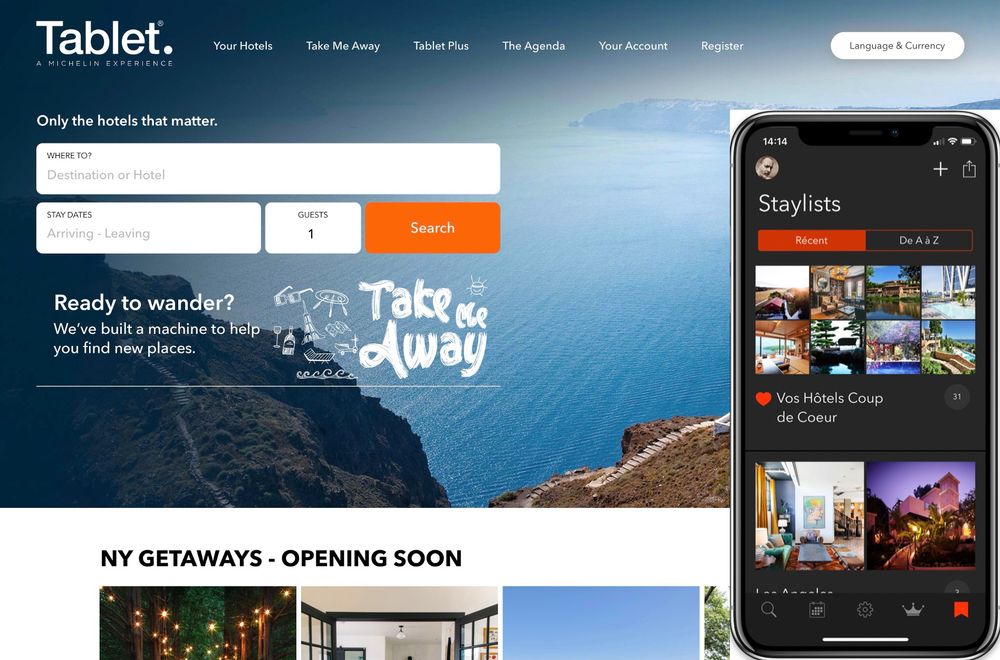
Tablet Hotels was created 20 years ago as a booking engine for hotels to use on their own site. In exchange, when a deal was made, Tablet Hotels received a % of the booking AND an access to the user data. It was this move early one that allowed Tablet Hotels to survive the internet crash & 9/11 event in 2001. It also fueled our site with a user base we could market to. Then they started to pivot their business model and get into the intermediation platform business. If you think about it, a decade ago, it was not so easy to find good hotels on the internet and Tablet Hotels got specialized in the business of matching business+ consumers with boutique & luxary hotels. Proposing the best hotels that fit your lifestyle through a seemless experience was their creed and it got re-enforced with Internet giants such as Google or Tripadvisor that make consumer life harder with an exhaustive but unpredictible hotel selection. As any intermediation platform, Tablet Hotels had to come up with a value proposal for both consumers and hotel owners to make the platform attractive and ensure there were enought demands and offers. A transaction on Tablet Hotels is:when a consumer books an hotel, they get a percentage on it. In addition to this fee approach, they also sucessfully implemented a subscription model with the Tablet Plus program that provides " VIP treatment at hundreds of participating Plus hotels, with perks like room upgrades, free breakfast, late check-out, airport transfers, spa credit, and more..." to their members. It allows them to generate cash fees BUT ALSO creates a loyalty program in a business where users show very little loyalty. You are more likely to keep using the product that you are paying for.
Tablet Hotels is a very good use case to illustrate that being a platform company
- is all about increasing the number of transactions.
- is more of a mindset than technology challenge
A key to the platform, since it is consumer facing, is the User eXperience - not to be confused with User Interface. The UX is built around the needs of the consumer & the feel of the brand (think of Tesla & Apple) - It is not ‘engineering’ per se but in fact is often overlooked in the overall success and what makes one platform better than others. It's no suprise then that one of the two founders of Tablet Hotels, Michael Davis, is the Chief Creative Officer. He's the product manager and the product owner for everything that is seen by consumers. It means that from the beginning the focus was on the client and the UX. Many companies see UX as a service component but in actuality it is what defines the consumer-experience. Many companies trying to switch to consumer facing have trouble because they are used to design solutions for themselves and internal goals.
We used the platform canvas on Tablet Hotels to try to show the different perspectives you have to consider before adopting the platform business model. What are your interaction and the value propositions for both providers (hotel owners) and consumers? How do you valorize it? What are the competitors you have in your market ? ...
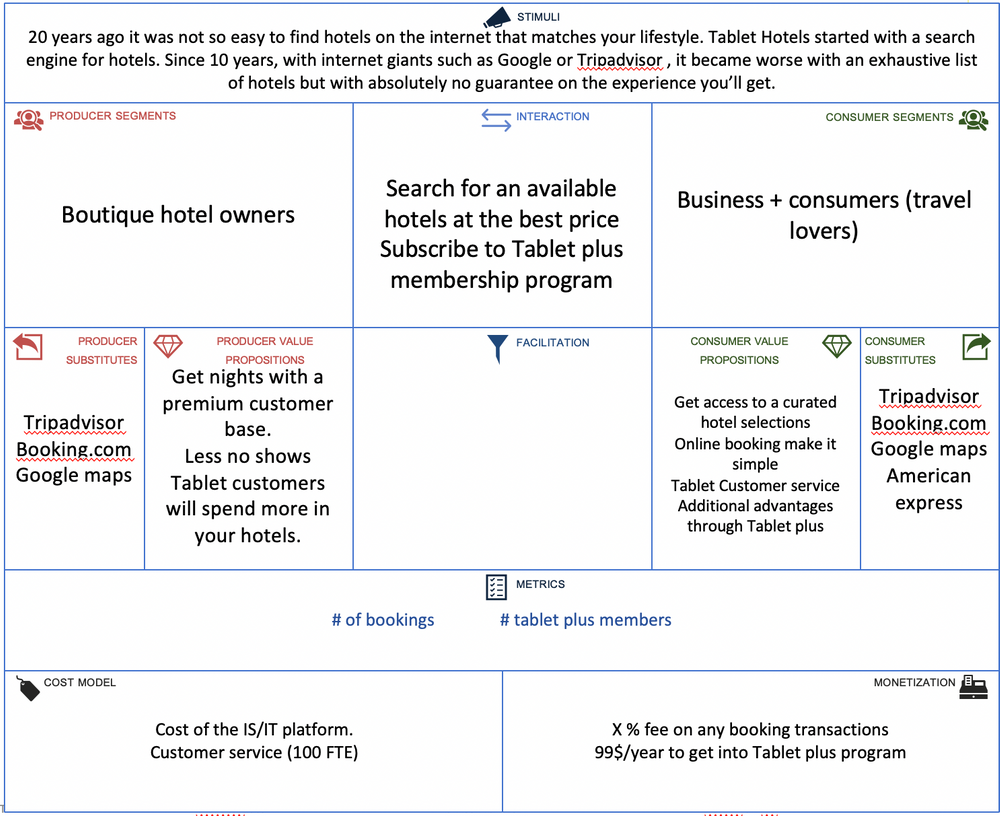
Growing communities is long and painfull and Tablet Hotels is no exception here. We can think of the below network effect but it's not that simple as you'll see. The more hotels we have, the bigger geographic presence we get. Consumers will get more results when looking for an hotel and at then end it's very likely that more bookings will be made. To increase the booking rate, Tablet introduced the Tablet Plus membership program that pushed subscribers to make worth the investment ("I am investing 99$/year, let's get the more out of it"). The more bookings you have, the more solid value proposal you get for hotel owners and that pushes owners to get into this hotel selection. The circle is closed now!
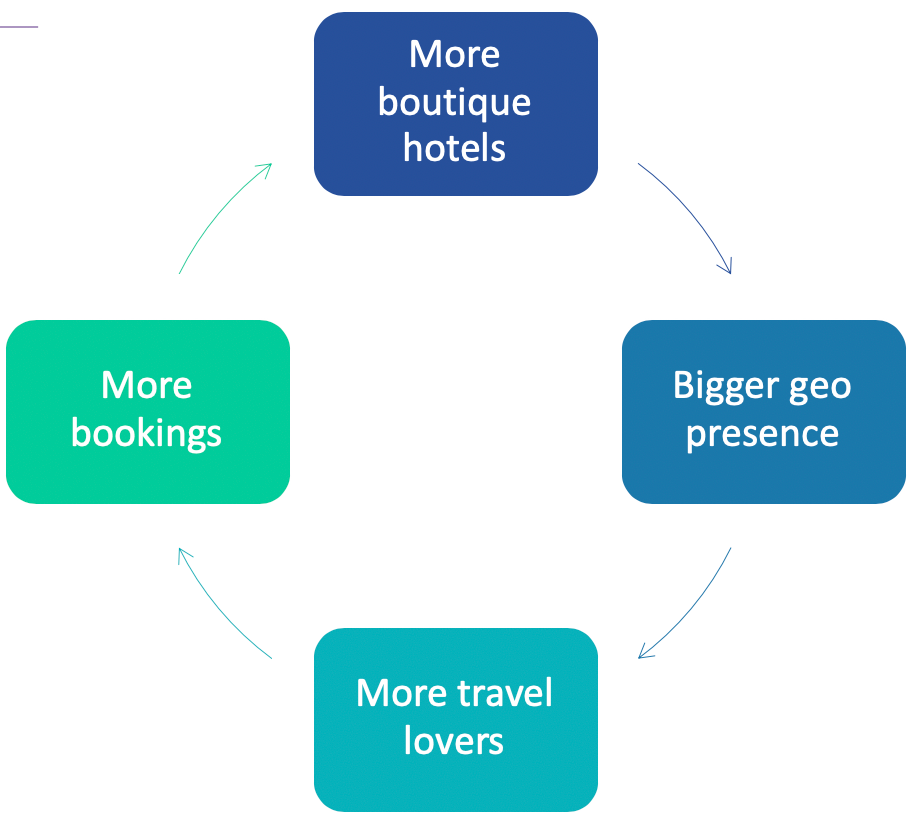
Although this may be true mathematically, UX-wise the difference in the product is the limited hotels selection (like Michelin Guide for restaurants). There is a diminishing return in the brand appeal if we add too many hotels (Tablet Hotels would be another TripAdvisor). The real key to growth is the user acquisition and the cost per transaction (which is highest among Tablet Plus members): it’s a very delicate balance between having the right number of hotels and maintaining the exclusivity and selection priorities. So what happens in fact ? Tablet Hotels uses the commission model to generate the revenue but it's capped by the number of hotels & commission percentage they are able to get. This is subject to competition BUT if they migrate the users to become Tablet Plus members, then we shift to a cash fee and higher commissions due to the nature of the user. The end goal is actually to create more Tablet Plus members, who are repeat customers spending more. They don’t need more marketing dollars to be spent on them in the form of ads but now the shift is for more benefits. It's important to keep in mind that Tablet Hotels spent years to build a curated hotels selection through their initial value proposal on the search engine. It's this way they fixed the "chicken and egg problem": if a platform do not have enough offer, consumer won't stay and if they is not enough consumers, publishers will leave.
So the network effect valid for Tablet Hotels is more like the below picture:
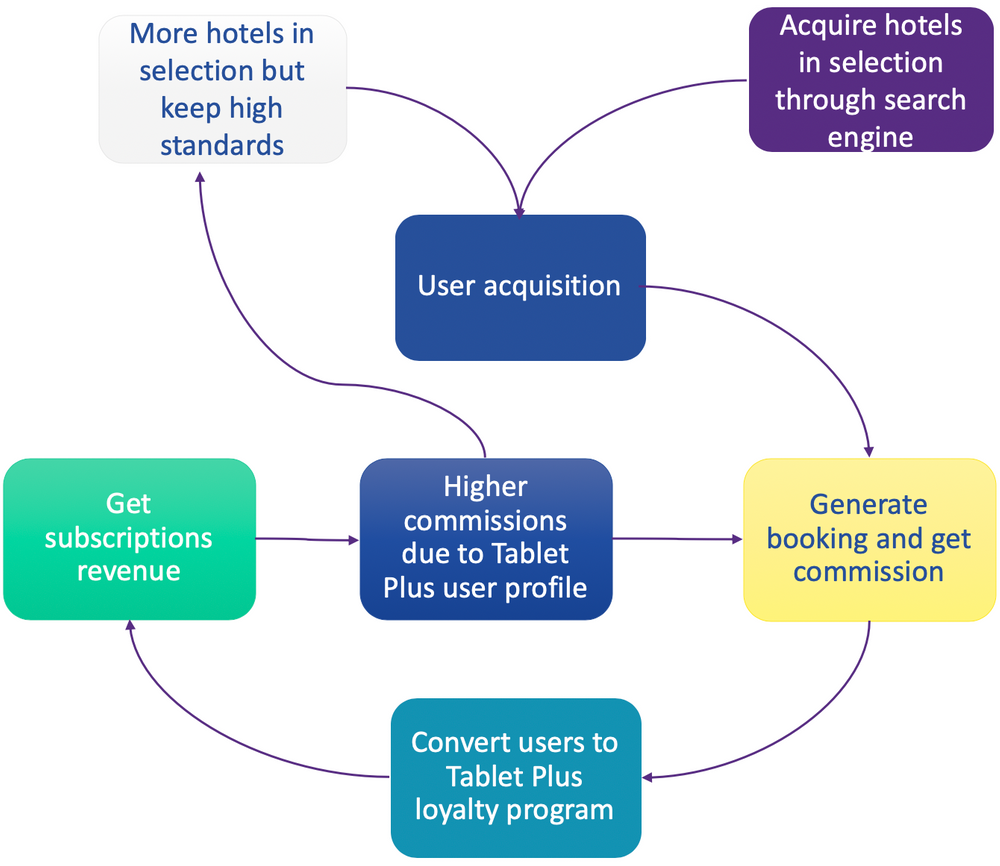
In term of maturity and mindset on the platform model, Tablet Hotels is probably the most advanced at Michelin. They know their users and their pains & desires extremly well. They are obsessed by the user experience and it's no surprise that their product owner is the UX designer in chief. In the B2C world, if your user experience is not frictionless, your users will leave your platform. By the way, there is no reason it would be different for internal only platform. Those who believes that a top down mandate is enough are making mistakes if you ask me. Back to Tablet: not only they deliver a smooth and polished experience but they also listen to their end users. Their behavior is analysed to get an even better the experience. They also used their community to contribute to the curation of their hotels' list: through verified comments, end users can rate hotels and this what make them in or out of the selection. That's an interesting curation model way different that what we have for restaurants (for which we have dedicated inspectors). Last but not least, we have a lot to learn in term of governance: they use the feedback they get from their users to improve continuously their platform and make it closer to their expectations.
In terms of delivery, it's interesting to see how they build and run their platform on a day to day basis. From a build perspective, they have a platform team able to impact their whole stack (web portal, mobile app, booking engine, CMS ...). Beside it, they do have back office systems (the CRM system in which they store hotels for instance) but as they don't consider it core to their business, it's not managed by the core platform team. Of course, they implement the "Your build it, you run it model which makes the team quite aware of the operability topics. If their platform does not work, not only they are loosing money but they start loosing users and that's even worse.
Technology wise, they developed their platform using
- python / MySQL (for their back office features) data base hosted in a New York premise
- HTML / Javascript for the web portal
- a native iOS app.
For a year or so, they are progressivly adopting Amazon AWS both in an Infrastructure as a Service and Platform as a service approach.
They have solid technical foundations and their move to the cloud put them in a good situation to scale: once again it's all about finding new users, push them to make booking transactions and convert them into Tablet Plus members.

